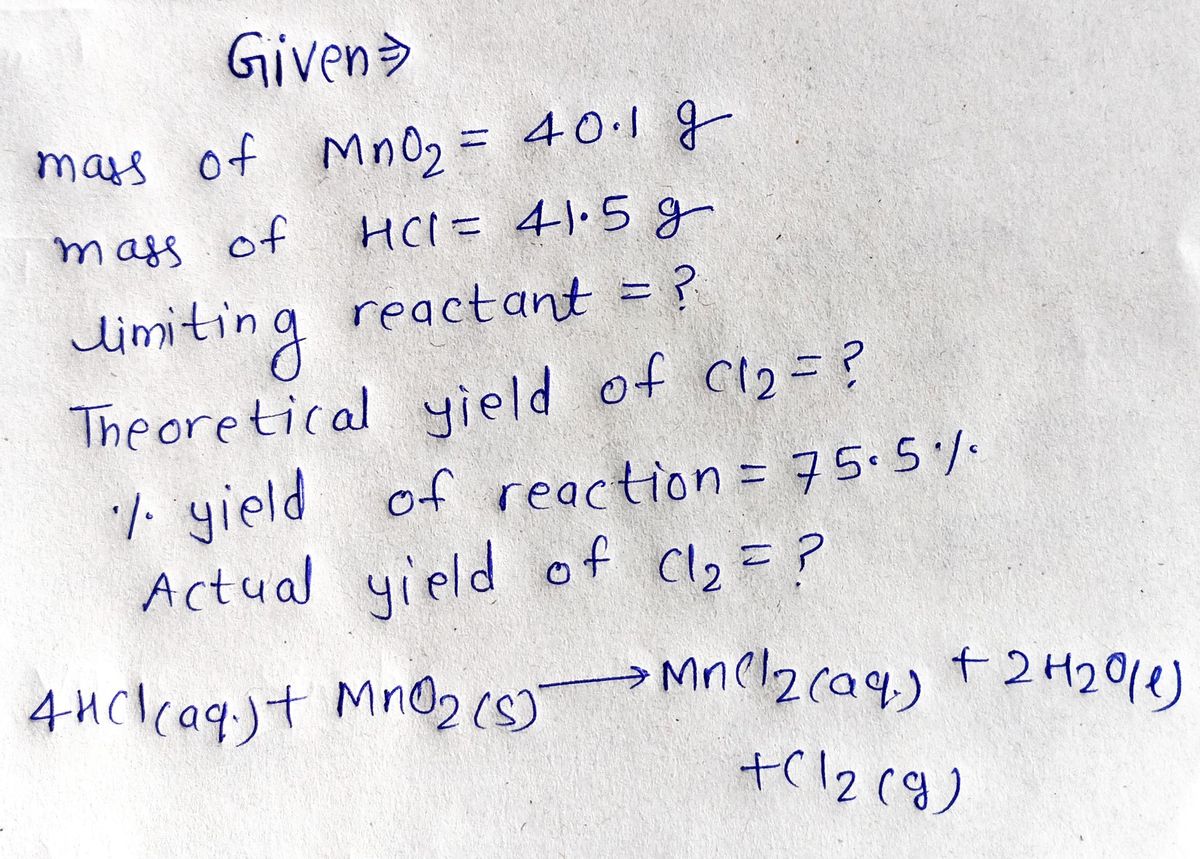Chlorine gas can be prepared in the laboratory by the reaction of hydrochloric acid with manganese(IV) oxide. 4 HCl(aq) + MnO₂ (s) →MnCl₂ (aq) + 2 H₂O(1) + Cl₂(g) A sample of 40.1 g MnO₂ is added to a solution containing 41.5 g HCl. What is the limiting reactant? O MnO₂ HCI What is the theoretical yield of Cl₂? theoretical yield: 8 Cl₂
Chlorine gas can be prepared in the laboratory by the reaction of hydrochloric acid with manganese(IV) oxide. 4 HCl(aq) + MnO₂ (s) →MnCl₂ (aq) + 2 H₂O(1) + Cl₂(g) A sample of 40.1 g MnO₂ is added to a solution containing 41.5 g HCl. What is the limiting reactant? O MnO₂ HCI What is the theoretical yield of Cl₂? theoretical yield: 8 Cl₂
Chemistry
10th Edition
ISBN:9781305957404
Author:Steven S. Zumdahl, Susan A. Zumdahl, Donald J. DeCoste
Publisher:Steven S. Zumdahl, Susan A. Zumdahl, Donald J. DeCoste
Chapter1: Chemical Foundations
Section: Chapter Questions
Problem 1RQ: Define and explain the differences between the following terms. a. law and theory b. theory and...
Related questions
Question
Help
![### Preparation of Chlorine Gas in the Laboratory
Chlorine gas can be prepared in the laboratory by the reaction of hydrochloric acid with manganese(IV) oxide.
\[ 4 \text{HCl(aq)} + \text{MnO}_2(s) \rightarrow \text{MnCl}_2(aq) + 2 \text{H}_2\text{O}(l) + \text{Cl}_2(g) \]
In this experiment, a sample of 40.1 g of MnO₂ is added to a solution containing 41.5 g of HCl.
**Questions to Consider:**
1. **What is the limiting reactant?**
- MnO₂
- HCl
2. **What is the theoretical yield of Cl₂?**
- Theoretical yield: ______ g Cl₂
In this experiment, you must identify the limiting reactant and calculate the theoretical yield of chlorine gas (Cl₂) based on the given masses of MnO₂ and HCl.](/v2/_next/image?url=https%3A%2F%2Fcontent.bartleby.com%2Fqna-images%2Fquestion%2Ff5fc9088-6d0a-4312-bffe-77961b56b51f%2F8b67750a-5c86-458a-b3c1-e6ac925af196%2Fnm3n51_processed.jpeg&w=3840&q=75)
Transcribed Image Text:### Preparation of Chlorine Gas in the Laboratory
Chlorine gas can be prepared in the laboratory by the reaction of hydrochloric acid with manganese(IV) oxide.
\[ 4 \text{HCl(aq)} + \text{MnO}_2(s) \rightarrow \text{MnCl}_2(aq) + 2 \text{H}_2\text{O}(l) + \text{Cl}_2(g) \]
In this experiment, a sample of 40.1 g of MnO₂ is added to a solution containing 41.5 g of HCl.
**Questions to Consider:**
1. **What is the limiting reactant?**
- MnO₂
- HCl
2. **What is the theoretical yield of Cl₂?**
- Theoretical yield: ______ g Cl₂
In this experiment, you must identify the limiting reactant and calculate the theoretical yield of chlorine gas (Cl₂) based on the given masses of MnO₂ and HCl.
![**Chemistry Exercise: Determining the Limiting Reactant and Yield of Chlorine Gas**
1. **What is the limiting reactant?**
- [ ] MnO₂
- [ ] HCl
2. **What is the theoretical yield of Cl₂?**
- Theoretical yield: [_______] g Cl₂
3. **If the yield of the reaction is 75.5%, what is the actual yield of chlorine?**
- Actual yield: [_______] g Cl₂
**Instructions:**
- Select the limiting reactant from the options provided.
- Calculate the theoretical yield of Cl₂ based on the reaction.
- Use the given percentage yield to determine the actual yield of chlorine gas.](/v2/_next/image?url=https%3A%2F%2Fcontent.bartleby.com%2Fqna-images%2Fquestion%2Ff5fc9088-6d0a-4312-bffe-77961b56b51f%2F8b67750a-5c86-458a-b3c1-e6ac925af196%2F1em63ot_processed.jpeg&w=3840&q=75)
Transcribed Image Text:**Chemistry Exercise: Determining the Limiting Reactant and Yield of Chlorine Gas**
1. **What is the limiting reactant?**
- [ ] MnO₂
- [ ] HCl
2. **What is the theoretical yield of Cl₂?**
- Theoretical yield: [_______] g Cl₂
3. **If the yield of the reaction is 75.5%, what is the actual yield of chlorine?**
- Actual yield: [_______] g Cl₂
**Instructions:**
- Select the limiting reactant from the options provided.
- Calculate the theoretical yield of Cl₂ based on the reaction.
- Use the given percentage yield to determine the actual yield of chlorine gas.
Expert Solution
Step 1

Step by step
Solved in 4 steps with 4 images

Knowledge Booster
Learn more about
Need a deep-dive on the concept behind this application? Look no further. Learn more about this topic, chemistry and related others by exploring similar questions and additional content below.Recommended textbooks for you

Chemistry
Chemistry
ISBN:
9781305957404
Author:
Steven S. Zumdahl, Susan A. Zumdahl, Donald J. DeCoste
Publisher:
Cengage Learning

Chemistry
Chemistry
ISBN:
9781259911156
Author:
Raymond Chang Dr., Jason Overby Professor
Publisher:
McGraw-Hill Education

Principles of Instrumental Analysis
Chemistry
ISBN:
9781305577213
Author:
Douglas A. Skoog, F. James Holler, Stanley R. Crouch
Publisher:
Cengage Learning

Chemistry
Chemistry
ISBN:
9781305957404
Author:
Steven S. Zumdahl, Susan A. Zumdahl, Donald J. DeCoste
Publisher:
Cengage Learning

Chemistry
Chemistry
ISBN:
9781259911156
Author:
Raymond Chang Dr., Jason Overby Professor
Publisher:
McGraw-Hill Education

Principles of Instrumental Analysis
Chemistry
ISBN:
9781305577213
Author:
Douglas A. Skoog, F. James Holler, Stanley R. Crouch
Publisher:
Cengage Learning

Organic Chemistry
Chemistry
ISBN:
9780078021558
Author:
Janice Gorzynski Smith Dr.
Publisher:
McGraw-Hill Education

Chemistry: Principles and Reactions
Chemistry
ISBN:
9781305079373
Author:
William L. Masterton, Cecile N. Hurley
Publisher:
Cengage Learning

Elementary Principles of Chemical Processes, Bind…
Chemistry
ISBN:
9781118431221
Author:
Richard M. Felder, Ronald W. Rousseau, Lisa G. Bullard
Publisher:
WILEY